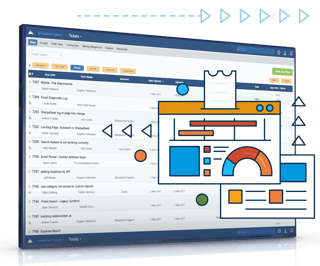By Carrie Dagenhard (Tech Writer)
Are you in the market for a new IT helpdesk software? Let's explore the crucial issues to consider in order to select the best IT software for your business and your team.
How To Choose The Right IT Helpdesk Software For Your Business?
Smart IT managers understand that the IT helpdesk solution they choose for their business will impact nearly every facet of their operations, including the accuracy and speed of ticket resolutions and therefore their customers’ satisfaction.
Things do get a bit more complicated when IT managers face budget constraints, as they may not be able to afford to review the wide selection of the IT Helpdesk software available.
To help narrow the list and help IT Managers make the right decision for their businesses, we’re sharing ten crucial things to consider when searching for the right IT helpdesk software tool:
Support
Before choosing any software product for your organization, it’s vital you evaluate the provider’s support capabilities. Consider whether they offer support across multiple channels, such as by phone, email, live chat, social media, and more. Also, be sure to find out whether support is available 24/7 and ask how quickly they typically resolve their users’ questions and concerns.

Given the entire purpose of helpdesk software is to assist your team in solving problems, if the provider doesn’t offer reliable support, it doesn’t bode well for the quality of their product.
Integrations
You and your team likely rely on several different tools and technologies to complete your work efficiently and effectively. And you’ve probably discovered that when a piece of software fails to integrate with other tools, it slows down your team’s workflow and creates points of friction. That’s why it’s critical you ensure your helpdesk solution plays well with other essential programs and applications, such as your remote monitoring and management (RMM) software. Also, bonus points if the product integrates with your time-tracking, invoicing, data reporting, and knowledge base solutions. (Or, better yet, opt for an all-in-one PSA solution.).
Productivity
Every software you bring into your organization should support and maximize your team’s productivity — not detract from it. Great helpdesk software will automate repetitive, time-consuming tasks and free up your team to get more done in less time (and alleviate burnout).
 It doesn’t matter if a tool is free if it’s also clunky, slow, and unnecessarily complicated. In the end, that will cost your team their time, energy, and job satisfaction — which is far more valuable than whatever you save by investing in sub-par software.
It doesn’t matter if a tool is free if it’s also clunky, slow, and unnecessarily complicated. In the end, that will cost your team their time, energy, and job satisfaction — which is far more valuable than whatever you save by investing in sub-par software.
Scalability
It’s never wise to opt for solutions with strict user limits or those that don’t update their product in response to evolving tech trends and user expectations. While nothing is truly future-proof, it’s best to choose IT helpdesk software that can grow and scale with your company. This way, as you add new members to your team and take on larger projects, you won’t have to abruptly change systems and go through the helpdesk software shopping process all over again. Take time to consider your company’s trajectory and opt for a tool that will support your evolution.
Ease Of Use
Before you decide to adopt a helpdesk solution, always take time to evaluate its user-friendliness. Is it mobile-friendly and accessible from anywhere? Is it easy to navigate? Is there a steep learning curve (will it take users a long time to get comfortable with the program), or will it fit seamlessly into existing processes?
 Remember to analyze ease of use not only for your team of tech experts but also consider whether it will be intuitive enough for less tech-savvy customers or users who will be entering tickets and requests. The more complex the software, the less likely people will use it as intended.
Remember to analyze ease of use not only for your team of tech experts but also consider whether it will be intuitive enough for less tech-savvy customers or users who will be entering tickets and requests. The more complex the software, the less likely people will use it as intended.
Features
Whether you’re considering free IT helpdesk software or something that’s top-of-budget, remember a product’s greatest value comes from its features — and the benefits they’ll create for your team. Here are a few features to look for:
Routing: Can you route issues to specific support queues or techs with expertise on the subject?
Grouping: Can you group similar or identical tickets for more streamlined management?
Custom Forms: Does the software allow you to create dynamic forms so you can clearly define users’ issues?
Alerts: Can you set up notifications for specific alerts for better monitoring?
Remote Assistance: Will you be able to chat live, share screens and files, and initiate remote sessions via email or inside tickets?
Data & Reporting
You can’t improve team efficiency unless you can monitor performance. It’s critical your helpdesk software offers insight into how quickly techs resolve tickets — and it’s even better if you can set goals and define times for each of your team’s priorities. 
Performance data and at-a-glance reporting can make your life easier when tracking KPIs, ensure your team is getting support where they need it, and help you get closer to achieving key objectives.
Customer Reviews
A software provider’s website is a helpful resource for information about a product’s features — but it’s essential you consider third-party review sites too. Customer reviews can offer insight into how other teams are using the software to meet their needs, whether the product works as advertised, and if any issues could impact how well the solution will work in your environment. Pay close attention to reviews from customers in your industry or those with similar-sized teams.
Implementation
Anyone who has ever spearheaded a software implementation project knows it can be a beast. From preparing your team and educating the workforce on the new product to handling integrations, setting permissions, and managing the inevitable back-and-forth with the provider’s support team, implementation requires a significant amount of time and energy.
 Before you choose your IT helpdesk software, ask the provider for insight into how other organizations have managed their roll-out and, if possible, find peers in the space who use the same solution. It’s important you have a good idea of what you’re getting into.
Before you choose your IT helpdesk software, ask the provider for insight into how other organizations have managed their roll-out and, if possible, find peers in the space who use the same solution. It’s important you have a good idea of what you’re getting into.
Cost
At first, this can seem a little counter-intuitive. If a product is “free,” then how would you evaluate cost? But many software providers that advertise their offering as free still require some investment. For example, some products operate on a “freemium” model in which you can use the basic version of the software for free but have to pay for more premium features. Others offer a free trial but charge a monthly or yearly subscription fee after the trial period expires. Then you have products like SherpaDesk, which are always 100% free for the first agent (with a small per-agent fee for each additional user).
Your helpdesk software is the foundation of your team’s support capabilities. The right software can help alleviate your team’s burdens and promote faster resolution of tech issues — but the wrong software will only create more headaches. By factoring these ten considerations into your decision, you’ll be much more likely to make the right choice.








comments